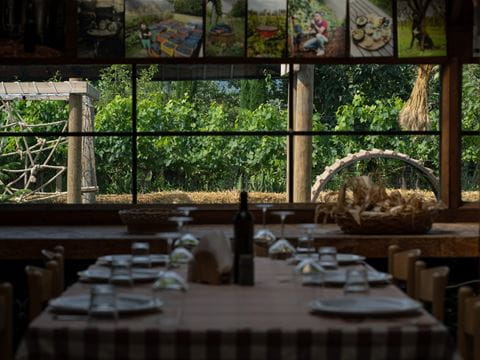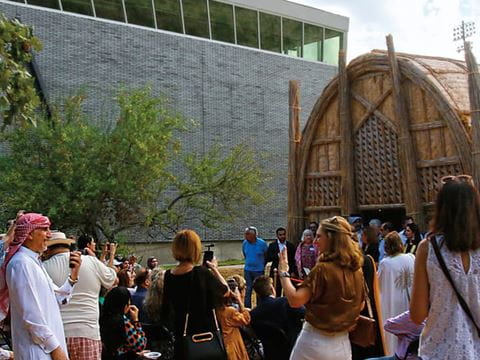Visualizing Where Food Comes From-Teaching Environmental and Social Impacts of Global Farming
Environmental Studies
Geography
Default Activity
No summary available
Default Activity
No summary available
Default Activity
No summary available
Default Activity
No summary available
Soaring Perspective on the Global Food Chain
George Steinmetz grew up in Beverly Hills, California, before the days of Hollywood glitz and glamor. But even then, his childhood wasn’t exactly bucolic. He lived in a bustling city where grocery stores always had fruits and vegetables, even ones that didn’t match the season. Grocery stores were stocked with produce that defied local growing seasons. Steinmetz experienced a typical urban American childhood that was predictable and safe.
After high school, he headed to Stanford University and studied geophysics, planning to work in the energy industry.
But after a short time in that field, Steinmetz chose a new path. He traveled to Africa, leaving behind his cloistered California life. While Hitchhiking across the continent, he rode on top of truck beds, ducked low-hanging branches and looking at the world from a giraffe’s-eye view. It reminded him of being a kid, climbing trees and seeing the world spread out below.
That search for wide view pulled him even higher—into the sky. Long before drones became common for photographers, Steinmetz began flying motorized paragliders. They lifted him high enough to capture the neat, patterned shapes of arms—but kept him low enough to meet the people working on the ground and tell their stories through his photos.
*IMAGE: Using a pole-mounted camera attached to his shoe, photographer George Steinmetz once took a self-portrait while piloting a motorized paraglider.
His first book, African Air, published in 2008, confirmed that his method work. After that, he kept landing major assignments that took him to more than 100 countries. Occasionally, his work even led to arrent arrest—in places like Libya, China and even Finney County, Kansas. This showed him, in his words, “that there are parts of our food system some of our bigger players don’t want us to see.”
Since then, Steinmetz has turned to using drones. From above, he captures detailed patterns in the land—patterns that reflect the land-use decisions made by people on the ground. As he explains, “From above, you can grasp the geography of land—and the enormous scale of feeding humanity.”
*IMAGE: These days Steinmetz more often sends a drone up to capture his images—sometimes under the watchful eye of curious young locals, as in 2016 in Indonesia.
In his most recent book, Feed the Planet: A Photographic Journey to the World’s Food, Steinmetz continues exploring how food is produced around the world. in nearly every corner of the world. He aims to show how deeply connected our global food system is. He hopes readers will “vote with their forks”, he says, on the kind of world they want to cultivate.
He spoke to AramcoWorld.
AW: This book is sweeping in its scale and scope. When did you realize an ambitious book like this was both possible and necessary?
GS: I was working on assignment in China, the world’s biggest importer of food, looking out how this growing demand influences the most industrialized nations: Brazil and the US. China has turned to the sea to feed their people, and [along] the coast of the East China Sea, many areas are covered in fish farms almost as far as you can see, like floating villages. And I would get a boat out to the fish farms, and I look at the sacks of fish meal and see they came from a Chinese company in Peru.
I was just scratching the surface, and I realized that to really tell the story, it had to be global. Food is kind of an infinite story because food is produced in virtually every country, and everybody eats, and it’s done in different ways. I realized that to give a sense of how global it was, I had a lot of traveling to do.
Above: Steinmetz documented the homes of the Bajau, a culture of fishermen and seaweed farmers, that are clustered on a man-made coral atoll off Bungin Island in Indonesia.
AW: The book is an anthology of individual visual stories about how the world of food works in various locales. But what is the larger narrative you’re trying to convey?
GS: I wasn’t trying to look at food from the aspect of gourmet or taste. It was more from an environmental perspective—most people don’t know where their food comes from except the supermarket.
AW: Were there places where traditional methods ended up being more desirable or financially sustainable?
GS: The almadraba, a 3,000-year-old fishing method used off the coast of Cadiz, Spain, is a really good example. It was invented by the Phoenicians. Bascially all the tuna coming through the Straits of Gibraltar to breed hug the coastline to avoid killer whales predating on them in the deeper water. Fishermen set up a labyrinth of nets to trap the Atlantic bluefin tuna, some of the most prized for sushi in the world, hundreds of kilos, beautiful fish. Because Atlantic bluefin became so overexploited in the open waters, the numbers were plummeting, and they started using the almadraba lmost like a scientific census but also as a sustainable way for the local people to make money and continue their tradition.
*IMAGE: Above: The almadraba, photographed off the coast of Cadiz, Spain, is a 3,000-year-old fishing method. Invented by the Phoenicians, promoted by the Romans and perfected by the Moors, it remains financially and ecologically viable.
AW: The book contains a key section on aquaculture, also called aquafarming. How globalized has the international fishing supply chain become, and how does this kind of trade affect local communities?
GS: It’s complicated. It’s shared resource, and a lot of the seafood we consume is migratory. During its life cycle, it will move from one country’s territory water to another to international waters. When you have a shared resource, it’s very easy for it to be overexploited because nobody really takes responsibility for the loss. It’s the tragedy of the commons.
How did that play out in places like Senegal and Mauritania, where you photographed hordes of pirogues (small boats) on the shores?
As a fishery declines, more pressure is put on people to go out and fish harder. Exactly the opposite of what you want to do to maintain your fish stocks. They go further and they get more desperate. Then people start using finer nets, catching the breeder fish and rapidly depleting the amount further and you quickly head towards collapse.
*IMAGE: In response to declining octopus numbers, the Mauritanian government has set new quotas and shortened the seas.
AW: Do you see tension between sustaining traditional aquaculture methods with the idea of improving productivity and adding new technology, as in the developed world?
GS: You find solutions on both the megascale and the microscale, like the artisan work with seaweed, which is a real bright spot in aquaculture because you’re growing food in a very sustainable way and hardly deforming the food chain. In Bali, people go in and harvest it by hand, so it provides jobs for the local community.
But you also see large-scale solutions. I was really impressed in Alaska, seeing how they’re managing the fishery there. They have scientists in towers on every river the salmon come up, and they don’t open the fishery until enough fish have gone past the checkpoint upstream so they’ll lay enough eggs for next year. Then, boom, by radio, all of a sudden, all the fishing boats start fishing.
*IMAGE: Steinmetz first scouted the seaweed farms of Bali, Indonesia, with Google Earth, “but when you are there, it’s always a surprise as you see people on the land (or on the water) and how they interact with it. It’s also more 3D, from the oblique perspective of the camera and, in this case, reflections.” He calls seaweed harvesting “a real bright spot in aquaculture because you’re growing food in a very sustainable way.
*IMAGE: In Bristol Bay, Alaska, fishermen pull in sockeye salmon from shore-based nets that catch the fish as they migrate upriver to spawn. “They don’t open the fishery until enough fish have gone past the checkpoint upstream so they’ll lay enough eggs for next year,” Steinmetz says.
AW: Your book dives into various other aspects of food, from meats to grain production. What message do you want readers to take away?
GS: I’d like people to think more about their food as an important environmental choice and that there’s a cumulative effect of their decisions. Food webs are very complicated, but as people start thinking about the source of their food and how it’s produced, that points in the direction of finding solutions, and it starts to put pressure on producers to make things with more environmental responsibility.
+++++
Reading Questions:
Question:What action have industrialized nations taken to meet the rising demand for foot in countries like China. Use details from the article.
They have turned to the sea to raise fish and other food through aquaculture. The article explains that countries are using fish farms to increase food supply and meet growing demands.
Question:Why does Steinmetz use aerial photography in his work? What does it help him—and others—see or understand?
Steinmetz uses aerial photography to show how land is used to produce food and how that connects to larger global systems. He believes that looking from above helps people understand the geography and scale of feeding humanity. His photos reveal patterns and impacts might not be visible from the ground.
Question:What does the article mean when it says readers can “vote with their forks”?
The phrase means people can make a difference through the food they choose to eat.
Other lessons

Hijrah: A Case Study in Migration and Turning Points
Explore concepts connected to an exhibit about the seventh-century-CE route from Makkah to Madinah.
Breaking Bread: Using Food As a Teaching Tool
Using food as a teaching tool, students widen their global understanding of other cultures while deepening their connection to the world.
Building a Mudhif: Overcoming Challenges to Achieve Sustainable Architecture.
Read how a community overcame challenges to replicate a traditional reed structure dating back 5,000 years.